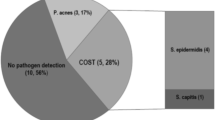Abstract
Background
Midshaft clavicle fractures are common, and the proportion of patients treated surgically has increased in recent years. With this increase in surgical treatments, the complication rate, for instance of infection, non-union, or implant failure, has also risen. This study evaluates the frequency of pathogen detection during revision surgeries occurring after a prior failed osteosynthesis of midshaft clavicle fractures.
Methods
All patients treated in our hospital with a prior failed surgical therapy of a clavicle midshaft fracture between January 2013 and March 2022 were screened. Epidemiological data, intraoperative tissue samples, sonication, and the type of revision surgery were assessed. A postoperative follow-up at a minimum of 6 month was defined and osseous consolidation was verified.
Results
Twenty-one patients (twelve male and eight female) were included with a mean age of 40.4 ± 14.1 years. Eleven of the patients showed pathogen detection (Group I), and seven remained without (Group II). A significant difference in age existed between Groups I and II (36.1 ± 12.8 and 51.6 ± 11.5, p ≤ 0.05). The three most common pathogens were Cutibacterium acnes (n = 7), Staphylococcus epidermidis (n = 4), and Staphylococcus sacchorlyticus (n = 3), respectively. Thirteen patients presented for a follow-up. In nine patients (69%), bone healing was detectable. Four patients received a second revision surgery.
Conclusion
Revision surgery frequently shows pathogen detection without signs of infection. Cutibacterium acnes is the most common pathogen. Despite pathogen detection, bone healing can be achieved with revision surgery, although the rate of repeat revision surgeries is high.


Similar content being viewed by others
References
Jeray KJ (2007) Acute midshaft clavicular fracture. J Am Acad Orthop Surg 15(4):239–248
Wolf S et al (2022) Surgical treatment, complications, reoperations, and healthcare costs among patients with clavicle fracture in England. BMC Musculoskelet Disord 23(1):135
Sharareh B, Perkins C (2020) Variation in management of humeral and clavicular shaft fractures amongst fellowship trained orthopedic traumatologists. BMC Musculoskelet Disord 21(1):618
Gausden EB et al (2017) Nonunion after clavicle osteosynthesis: high incidence of Propionibacterium acnes. J Orthop Trauma 31(4):229–235
Lim S et al (2022) Osteosynthesis with autologous dual bone graft for nonunion of midshaft clavicle fractures: clinical and radiological outcomes. Eur J Orthop Surg Traumatol 32(1):159–165
Kirchhoff C et al (2013) Operative management of clavicular non-union: Iliac crest bone graft and anatomic locking compression plate. Oper Orthop Traumatol 25(5):483–498
Mook WR et al (2015) The incidence of Propionibacterium acnes in open shoulder surgery: a controlled diagnostic study. J Bone Joint Surg Am 97(12):957–963
Sethi PM et al (2015) Presence of Propionibacterium acnes in primary shoulder arthroscopy: results of aspiration and tissue cultures. J Shoulder Elbow Surg 24(5):796–803
Both A et al (2018) Growth of Cutibacterium acnes is common on osteosynthesis material of the shoulder in patients without signs of infection. Acta Orthop 89(5):580–584
Fritsche T et al (2022) Tissue sampling is non-inferior in comparison to sonication in orthopedic revision surgery. Arch Orthop Trauma Surg. https://doi.org/10.1007/s00402-022-04469-3
McCarroll TR et al (2021) The incidence and incubation period of false-positive culture results in shoulder surgery. J Shoulder Elbow Surg 30(3):538–543
Hudek R et al (2014) Propionibacterium acnes in shoulder surgery: true infection, contamination, or commensal of the deep tissue? J Shoulder Elbow Surg 23(12):1763–1771
Pauzenberger L et al (2019) Cutibacterium acnes (formerly Propionibacterium acnes) contamination of the surgical field during shoulder arthroscopy. Arthroscopy 35(6):1750–1757
Hudek R et al (2016) Propionibacterium acnes in shoulder surgery: is loss of hair protective for infection? J Shoulder Elbow Surg 25(6):973–980
Funding
Open access funding was enabled and organized by Projekt DEAL.
Author information
Authors and Affiliations
Contributions
PH: drafting, writing, and revising the manuscript. BJ: data collection and revising the manuscript. HT: supervision and revising the manuscript. KD: project idea, study design, statistical analysis, and revising the manuscript.
Corresponding author
Ethics declarations
Conflict of interest
All authors declare that they have no conflict of interest.
Additional information
Publisher's Note
Springer Nature remains neutral with regard to jurisdictional claims in published maps and institutional affiliations.
Rights and permissions
Springer Nature or its licensor (e.g. a society or other partner) holds exclusive rights to this article under a publishing agreement with the author(s) or other rightsholder(s); author self-archiving of the accepted manuscript version of this article is solely governed by the terms of such publishing agreement and applicable law.
About this article
Cite this article
Hemmann, P., Brunner, J., Histing, T. et al. Revision surgery after failed surgical treatment of midshaft clavicle fractures is often associated with positive detection of bacteria. Arch Orthop Trauma Surg 143, 4133–4139 (2023). https://doi.org/10.1007/s00402-022-04669-x
Received:
Accepted:
Published:
Issue Date:
DOI: https://doi.org/10.1007/s00402-022-04669-x



